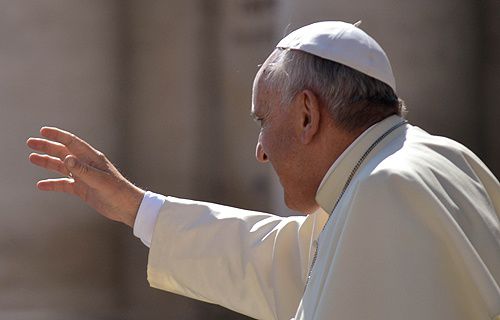During Pope Francis' encounter with a Catholicos of the Apostolic Armenian Church, the pontiff commended him for his efforts in fostering Christian unity, and encouraged a growth in trust and hope. “Your Holiness's commitment to the cause of Christian unity is known to all,” Pope Francis stated in his June 5 meeting with Catholicos Aram I of the Apostolic Armenian Church of Cilicia. “You have been especially active in the World Council of Churches and you continue to be most supportive of the Middle East Council of Churches, which plays such an important role in assisting the Christian communities of that region as they face numerous difficulties.” The Armenian Apostolic Church is an Oriental Orthodox Church. These Churches reject the 451 Council of Chalcedon, and have been considered monophysites — those who believe Christ has only one nature — by Catholics and the Eastern Orthodox. During his remarks, Pope Francis drew attention to the Catholicos' “significant contribution” to the ongoing dialogue between the Catholic Church and the Oriental Churches, saying he is “convinced” that the two “share the same hopes and a similar sense of responsibility” in their journey toward full communion. “Trust and hope. How much these are needed! They are needed by our Christian brothers and sisters in the Middle East, especially those living in areas racked by conflict and violence,” he observed. Going on, the pontiff explained that even as Christians who do not suffer from conflict we need these virtues, because so often we “risk losing our way in the desert of indifference and forgetfulness of God, or living in conflict without brothers and sisters, or succumbing in our interior struggle against sin.” “As followers of Jesus Christ, we need to learn humbly to bear one another’s burdens and to help each other to be better Christians, better followers of Jesus.” Taking place in the Vatican’s Redemptoris Mater chapel, the prayer was arranged as part of Aram I's June 5 - 6 visit to Rome, during which he is also slated to meet with the Pontifical Council for the Promotion of Christian Unity and visit the tomb of Saint Peter. Pope Francis' encounter with the Armenian Catholicos comes in wake of a meeting he had with the Armenian Patriarch Karekin II in the Vatican last month. Fr. Gabriel Quicke, a member of the Pontifical Council for the Promotion of Christian Unity who works specifically with the Oriental Churches and who played a key role in organizing both events, explained that Aram I’s visit with Pope Francis “is very significant.” “All the patriarchs and the heads of churches want to visit the Holy Father, and the Armenian Apostolic Church has had in its history very good relations with the Catholic Church” he observed, stating that “At every stage of their history there is evidence of this good relationship.” Describing the day’s schedule, Fr. Quicke explained that ahead of their prayer together, Pope Francis and Aram I had a private meeting, during which “the Catholicos expressed his thanks for the Holy Father for receiving him and for being able to express his solidarity.” “The Holy Father answered by expressing his closeness in prayer and he could greet the group of faithful” he said, noting that the group of laypersons selected to participate in the event following their private remarks hailed from countries all over the world. Following their speeches, the priest revealed that the two exchanged gifts before heading to the Redomptoris Mater chapel of the Apostolic Palace where they prayed together in each others’ languages. “Some prayers were in Armenian, there were some hymns in Armenian, for the rest we spoke in English and in Italian,” Fr. Quicke recalled, noting that “at the end of the prayer, the Catholicos and the Holy Father gave the blessing.” Observing how the atmosphere was very fraternal, he explained that the good relationship between Catholics and Armenians is particularly important given the painful past of the Arminian Church. In 1915, the Ottoman Empire began a genocide against the Armenian people, in which some 1 million were killed. “The Armenian people is a people in pilgrimage. They have suffered a lot, so the Armenian Apostolic Church has had to become a pilgrim people” with a history marked by immigration and persecution and martyrdom.” So it is significant, the priest explained that they still “continue their mission to be witnesses of the Risen Lord.”

